The Microsoft Surface Laptop 3 (15-Inch) Review: AMD Ryzen Surface Edition
by Brett Howse on October 21, 2019 9:00 AM EST- Posted in
- Laptops
- AMD
- Microsoft
- Surface
- Ryzen
- Surface Laptop
- Surface Laptop 3
AMD Ryzen Microsoft Surface Edition
Microsoft's decision to use an AMD processor was a bit of a surprise, since despite AMD’s resurgence in the desktop space, the company hasn’t spent as much of its focus on the laptop market. There are a multitude of reasons for this, but the end result has been that we haven't seen too many Ryzen Mobile laptops. AMD's biggest win to date has arguably been Lenovo's ThinkPad lineup, but getting into a Microsoft Surface machine is a greater achievement still.
The 15-inch Surface Laptop 3 incorporates what AMD and Microsoft are calling their "AMD Ryzen Microsoft Surface Edition" processor. Officially, they're classifying this as a semi-custom chip, though to quote our own Dr. Ian Cutress "the silicon inside the Surface Laptop 3 isn’t new: it is still the same Zen+ 12nm Ryzen silicon we see in other Ryzen notebooks today, however it has been binned specifically with 11 compute units at 15W, rather than what we see in the market today"
Still, what Microsoft is getting for their Surface Laptop 3 is not an off-the-shelf design. For their co-designed platform, there are two important aspects that give them a semi-custom spin on things. First off, Microsoft is getting a specialized bin of AMD's Picasso APU silicon, which enables one more CU within the integrated GPU than AMD's standard APU bins. The second change is that the two companies have worked together to greatly refine the firmware, drivers, and software stack for the device, in order to deliver a better experience. And these changes should not be underestimated; we've seen bad firmware sink many a laptop, both AMD-powered and Intel-powered. AMD has long needed, a strong, interested partner to help them polish their Ryzen Mobile platform, and with Microsoft they finally have what they need.
Diving a bit deeper, let's look at the AMD Ryzen Microsoft Surface Edition processors. These chips use AMD's Zen+ CPU cores along with their Radeon Vega GPU architecture, and Microsoft will be offering two of these chips. The fastest of these chips is the Ryzen 7 3780U, which runs four CPU cores clocked at 2.3-4.0 GHz, and paired with 11 Vega CUs. The other, lower tier chip is the similar Ryzen 5 3580U, which also has four CPU cores running at 2.1-3.7 GHz, and is coupled with a 9 CU Vega iGPU. Both of these chips offer one CU more than a normal Ryzen 5 or Ryzen 7 mobile part – so we should see slightly better graphics performance – while still operating at the same 15-Watt TDP.
The choice of an AMD processor has also directly impacted the memory being used. Since AMD doesn’t support LPDDR4X on Picasso, Microsoft is using DDR4-2400 dual-channel memory. The use of DDR4 is less than ideal for a thin and light device since it doesn't incorporate the power-saving techniques of LPDDR4X, but it can be compensated for with some solid deslgn work and a slightly larger battery. For comparison's sake, Intel’s new Ice Lake chips do have LPDDR4X support, so we'd be likely to see better power consumption on the Intel-powered Surface Laptops. Hopefully AMD adds support for LPDDR4X in their next generation.
System Performance
For our review, Microsoft sent out one of their Ryzen 5 3580U-equipped machines. This means we're able to take a good look at the baseline performance of the Surface Latop 3 – the kind of performance the cheapest and highest-volume machines will deliver – but it also means we won’t be able to see what the laptop can do at its peak. Starting things off, let’s take a look at how the Surface Laptop 3 performs in our system benchmarks.
PCMark 10
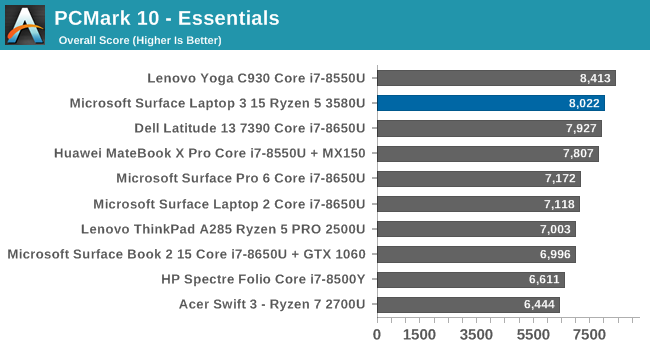
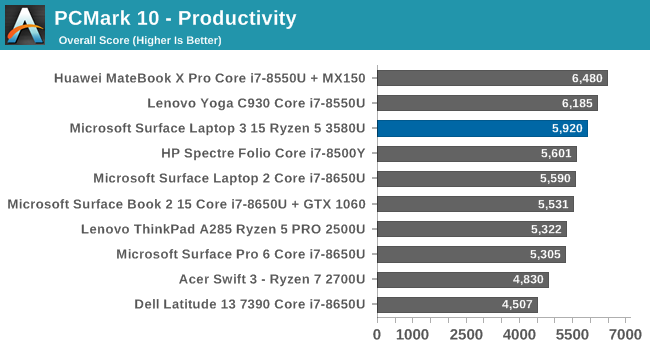
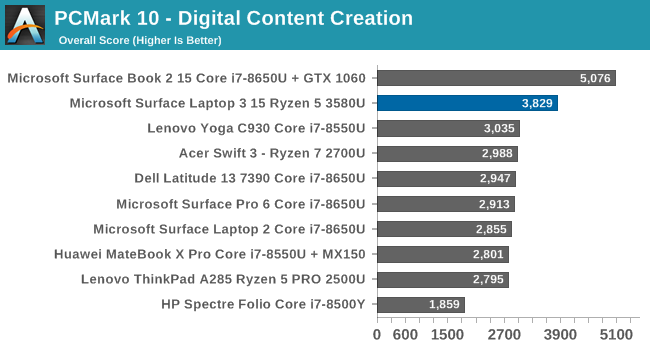
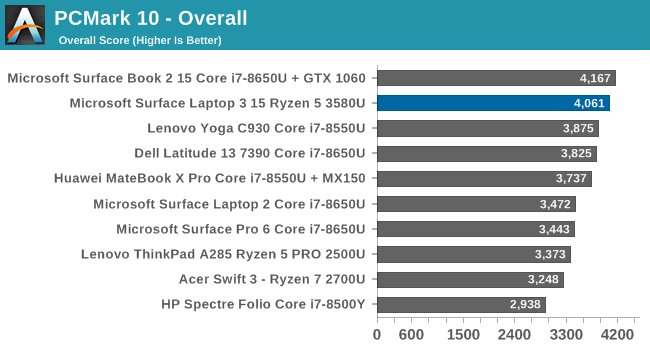
PCMark 10 tests all aspects of a system including the GPU, CPU, and storage, across several sets of subtests. The extra GPU grunt from the Vega 9 really helps in the Digital Content Creation test in particular, but the Zen+ core is competitive with the 8th generation Intel processors in the other tests as well.
Cinebench
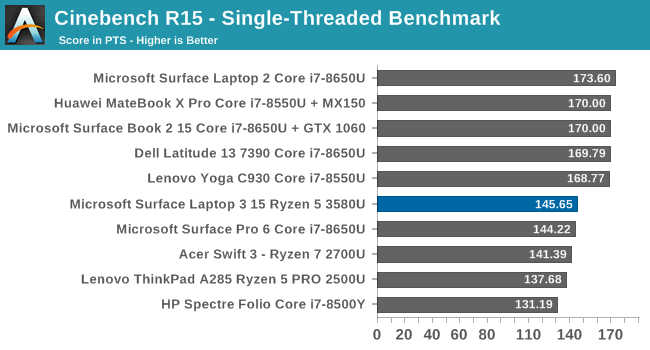
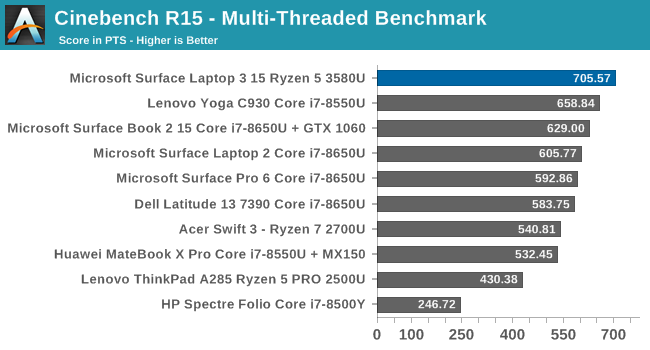
Cinebench offers both single-threaded and multi-threaded variations of its benchmark, and makes it very easy to see that the Zen+ core isn’t quite as quick as the Skylake based processors in the other laptops, but in the multi-threaded variation the Ryzen is able to flex its muscles and climb to the top.
x264
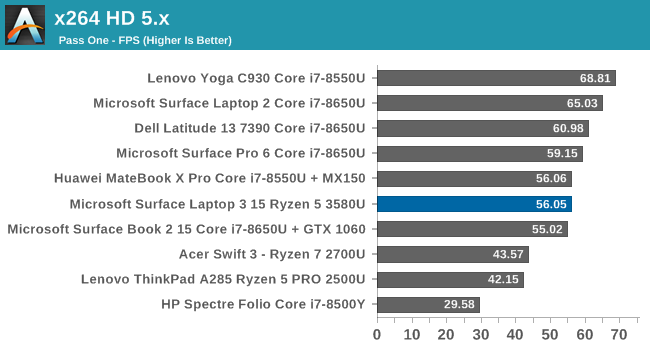

This video conversion test is very CPU intensive and long, meaning devices run into their thermal limits over the duration. The Ryzen 5 3580U once again holds its own here against the last generation Intel products.
Web Results
Browsing the web is easily one of the most popular activities on any PC, but web performance comes down to not only the system, but also the browser. For consistency all of our devices are tested with Microsoft Edge as the browser, which has actually regressed in performance over the last several updates. Microsoft is switching to a Chromium browser, which will become the new platform when it is available, along with some updated scripting tests.
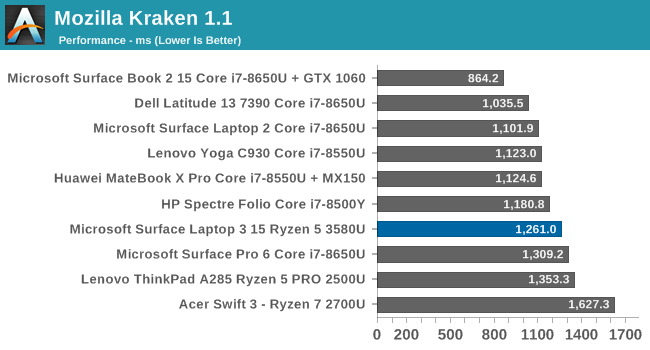

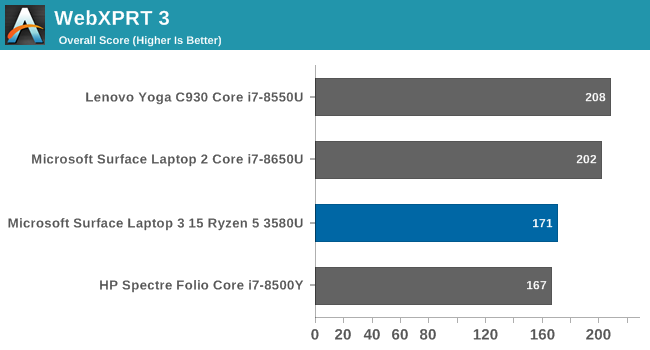

Intel’s Speed Shift technology pays dividends on the web tests, since the workloads quickly ramp up and down, so the AMD Ryzen isn’t quite as competitive in these tests, but the newer Zen+ is still a nice bump in performance over the original 2700U Raven Ridge APU.
Storage Performance
Over the last couple of generations, Microsoft has been utilizing soldered-in BGA SSDs to save space in their designs, but those SSDs were limited to just two PCIe lanes. With the latest round of devices, the SSD is once again removable via an M.2 slot, with Microsoft using a smaller than normal 2230 form factor. Although the SSD isn’t easily replaceable, it is replaceable if necessary, which is a win for consumers on the repair side.
The 2230 drive in our review unit is an SK Hynix model with just 256 GB of space (other models come with a Toshiba BG4) so it doesn’t offer spectacular SSD performance compared to the best 2280 drives on the market. But still gets the job done and does offer the PCIe x4 connectivity the soldered-down models lacked.


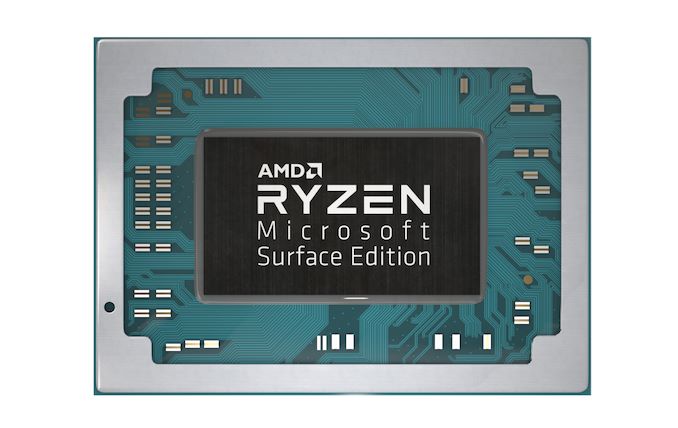
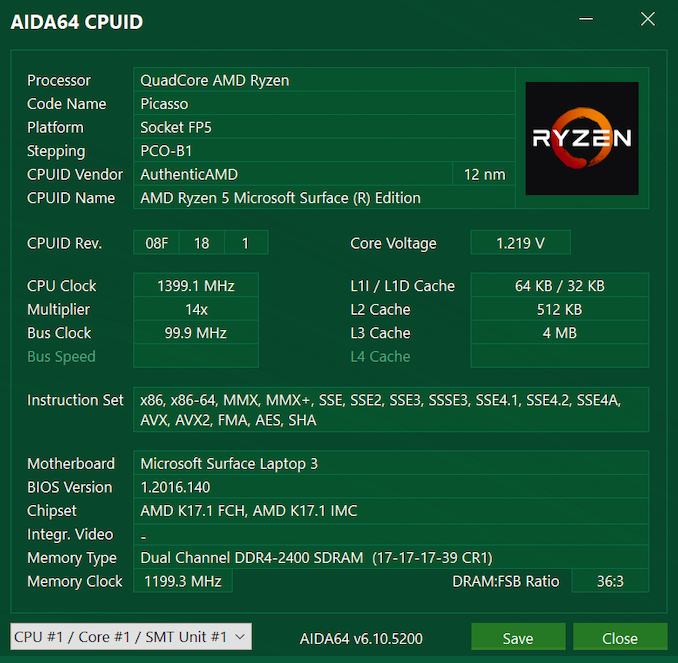
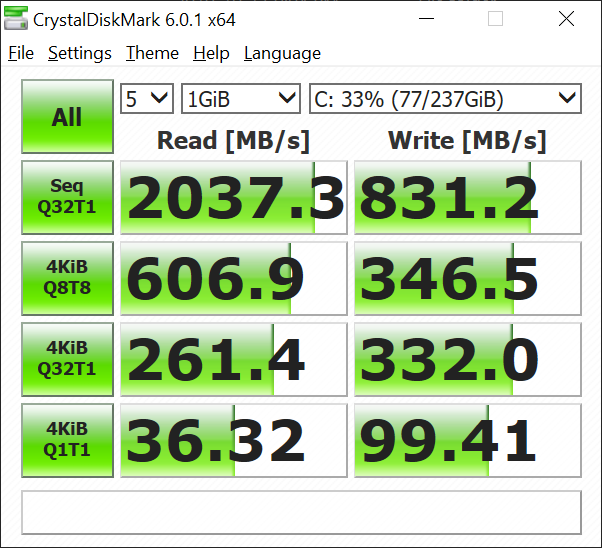








91 Comments
View All Comments
Icehawk - Thursday, October 24, 2019 - link
I get that we always want the best but I honestly don't know why it's harped on about how this device "only" does ~315 which is about as fast as a SSD can handle anyway - 1G connects for a single machine just don't matter in real life. More important to me is how reliable the connection is, which according to this review is solid.Eliadbu - Monday, October 21, 2019 - link
I'll give that the GPU is compelling but all other aspects of the APU are mediocre, especially the battery life which worse than average. I would like to see how the ice lake version compares to this APU.I think this machine proved why Intel still dominates the low power/thin and light laptops market.
Irata - Monday, October 21, 2019 - link
Did you look at the system performance benchmarks? Ryzen 5 does pretty well there (second place overall in PC Mark 10) and the list does not include any Core i5, only core i7.The only laptop that has a higher score is the top of the line Surface Book 2 with an i7 plus nVidia dGPU.
The Ryzen model tested here is the base model, btw.
Yes, battery life could certainly be better (although they do not test how well it does under load), but Surface Book Ryzen us not the worst - there are Intel based models that do less well.
phoenix_rizzen - Monday, October 21, 2019 - link
Yeah, if you consider this is the middle-of-the-road APU (R5) from AMD being benched against the top-of-the-line CPUs (i7) from Intel, it does really well. For most of the CPU benchmarks, it's right in the middle of the i7 pack. For most of the GPU benchmarks, it's better than the iGPU, as good as the MX150 dGPU, although not nearly as good (as expected) as the 1060 dGPU.Would be interesting to see how this APU compares to i5 versions of these laptops.
Would also be interesting to see how the R7 APUs compare to the i5 and i7 versions of these laptops.
Eliadbu - Monday, October 21, 2019 - link
this is 8th gen, meaning we are comparing to the past products, you talked about r7 but from what I've seen we are talking 100-200mhz difference (so 5% difference at most ). also the TDP will get up as clock speed goes up which equal to more heat,worse battery life etc. many test that it did perform good is due the GPU as I said it is compelling but is it enough I would say no, and for testing battery life under load I would say while it might have some use cases most people will use the laptop on battery for basic tests like browsing the web, watch videos, edit documents or other light use programs. if the r5/r7 had lower price I would give it more favor but as it stands out it does not give us any discount, it may have been due Microsoft pricing tactics but it does not change the fact. also we need to see how it compares to ICL version of this machine. I would guess it would still have the better GPU but the gap would shrink significantly, and CPU would not be it strong side either.Potato Power - Thursday, October 24, 2019 - link
Microsoft puts a 46Wh battery inside. That explains why the battery life is only so so. Even my cheapy Zenbook has a bigger battery.sorten - Monday, October 21, 2019 - link
Decent showing against previous generation Intel options, meaning it wasn't as far behind as I expected. Unfortunately for AMD, Ice Lake offers better than 2x the iGPU performance of 8th gen chips, and there will also be a minor bump on CPU performance, battery performance, and memory speed.Kishoreshack - Monday, October 21, 2019 - link
People overreacting should understand this is the base model, for a base model it competes very we with top end models of last yearI would be really excited to see higher end models of surface laptop 3
AMD VS INTEL COMPARISON
Felt that surface should have integrated ZEN 2 ARCHITECTURE INTO THESE LAPTOPS
TheinsanegamerN - Monday, October 21, 2019 - link
Except this "base" model has worse IRL GPU performance, worse batery life, and worse wifi. It is a step backwards. AMD GPUs are supposed to be better then intel, but the graphs here show that is not hte case unless power isnt a consideration.Kind of hard for MS to use ZEN 2 ARCHITECTURE APUs when they refuse to make them. AMD is just crippling themselves here.
Fulljack - Tuesday, October 22, 2019 - link
eh, it shows the igpu as the most powerful one, even beating mx150 which is a dgpu on some scenario. too bad the graph still hasn't show Intel gen11 graphics. so I don't get what do you mean by worse irl gpu performance.of course, as expected, it won't beat gtx 1060 due to sheer amount of difference both in tdp and die size.